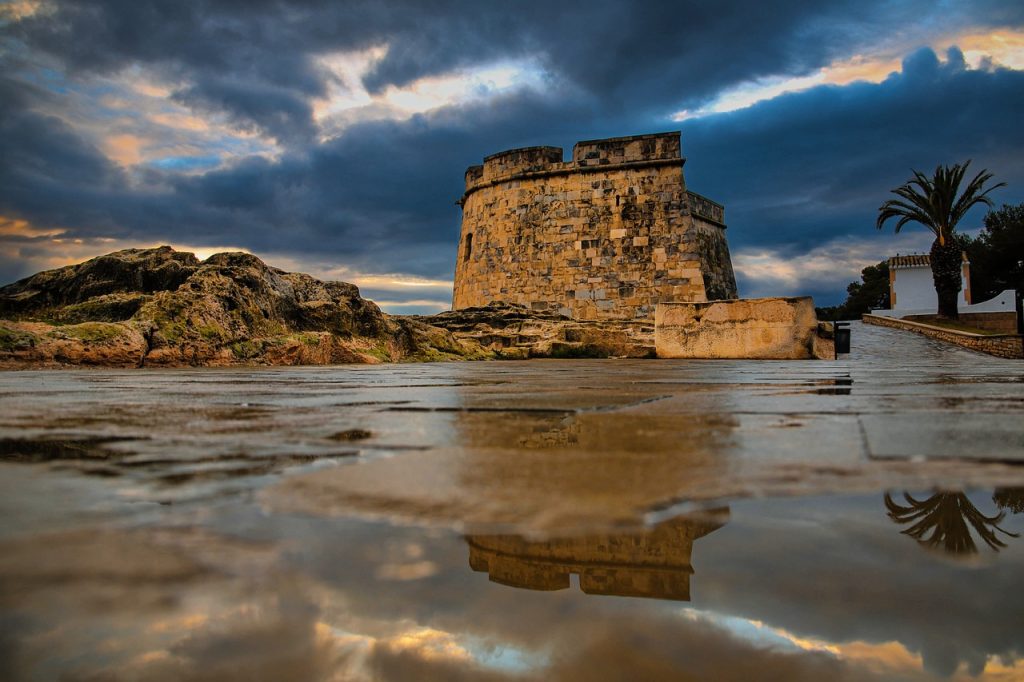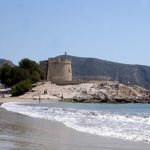Nestled on the southeastern coast of Spain, Moraira presents itself not just as a picturesque seaside town but as a guardian of history, encapsulated within its castles and watchtowers. These structures, standing against the test of time, offer a glimpse into the past, telling stories of invasions, battles, and the resilience of its inhabitants. This article embarks on a historical journey, exploring the significance of Moraira's castles and watchtowers, unraveling their stories and the roles they played in shaping the region's history.
Castillo de Moraira
The most prominent historical structure in Moraira is the Castillo de Moraira, also known as Moraira Castle. Built in the 18th century, specifically in 1742, this fortress was designed to protect the town and its harbor from pirate attacks. The castle is notable for its unusual shape; it features a unique, squat design with a rounded bastion, which allowed for a 360-degree range of defense against invaders coming from the sea. Constructed from local stone, the castle today stands as a testament to the town's historical defense mechanisms and is a popular attraction for visitors interested in the region's past.
Watchtowers of Moraira
In addition to the castle, Moraira was once guarded by a network of watchtowers built along the coastline and the surrounding hills. These towers played a crucial role in the town's defense system, serving as lookout points for spotting approaching pirate ships and alerting the inhabitants of potential danger.
Torre Vigía del Cap d'Or
One of the most significant of these watchtowers is the Torre Vigía del Cap d'Or, located on the headland of Cap d'Or. This 16th-century tower was strategically placed to oversee the coastline and provide early warnings of incoming ships. The tower's elevated position offers panoramic views of the Mediterranean Sea, making it a valuable asset in the defense against pirate raids. Today, the tower is accessible to visitors willing to hike up to the headland, offering both historical insights and breathtaking views.
Other Watchtowers
While the Torre Vigía del Cap d'Or is the most well-known, other watchtowers also contributed to the defense of Moraira and its surroundings. Though not all have survived to the present day, historical records indicate that these towers formed an interconnected system of surveillance and defense, illustrating the lengths to which the inhabitants went to protect their homes from pirate threats.
The Strategic Importance of Moraira
Moraira, part of the Teulada municipality in the Alicante province, has always held strategic importance due to its location along the Mediterranean coast. Historically, it was a vantage point for monitoring the sea for incoming invasions or pirate attacks. The need for defense and vigilance led to the construction of various castles and watchtowers throughout the area, which served as both lookout points and fortresses against invaders.
Castillo de Moraira – The Heart of Defense
At the heart of Moraira’s defense system is the Castillo de Moraira, a fortress that dates back to the 18th century. This castle, with its unmistakable silhouette, stands proudly by the shore, a testament to Spain's efforts to protect its coastline from pirate attacks and invasions. Constructed in 1742, the Castillo de Moraira is an exemplar of military architecture of the time, featuring a robust, almost circular design to withstand bombardments and a single entrance that faces inland, away from direct attack from the sea.
The castle's walls, made from local stone, have witnessed numerous assaults and have played a pivotal role in safeguarding the inhabitants and their livelihoods. Today, it stands not only as a monument to the past but also as a symbol of Moraira's enduring strength and resilience.
The Watchtowers: Sentinels of the Coast
Complementing the defense provided by the Castillo de Moraira are the watchtowers that dot the coastline and the surrounding hills. These towers, built between the 16th and 18th centuries, were part of a vast network of lookout points stretching along the Spanish Mediterranean coast. Their primary purpose was to spot approaching pirate ships and alert the local population and nearby fortifications of impending danger.
Among these, the Torre Vigía de Cap d'Or stands out for its strategic location on the Cap d'Or headland, offering panoramic views of the sea and the coastline. Constructed in the 16th century, this tower was a crucial part of the early warning system against corsairs and pirates who once plagued the Mediterranean waters. The Cap d'Or tower, accessible only by foot, remains a popular destination for those interested in history and spectacular views.
The Evolution of Moraira’s Fortifications
Over the centuries, the castles and watchtowers of Moraira have evolved from military fortifications to symbols of cultural heritage. The decline in pirate activity by the late 18th and early 19th centuries reduced the need for such defensive structures. However, these buildings have not lost their relevance. Instead, they have been embraced as integral parts of Moraira's history and identity.
In recent years, efforts have been made to preserve and restore these historical structures. The Castillo de Moraira, for instance, has undergone several restoration projects to maintain its structure and aesthetic, allowing it to continue serving as a focal point of community pride and a reminder of the town's historical significance.
The Castles and Watchtowers Today
Today, Moraira's castles and watchtowers are more than just relics of the past. They are vibrant parts of the community, serving as attractions for both locals and tourists. The Castillo de Moraira, with its imposing presence and historical significance, draws visitors from across the world, eager to explore its walls and learn about the town's storied past.
Similarly, the watchtowers, especially the Torre Vigía de Cap d'Or, offer unique insights into the defensive strategies of the past, as well as providing breathtaking views of the Mediterranean landscape. These structures also play a role in local festivals and events, serving as picturesque backdrops to celebrations of Moraira's culture and history.
Conclusion
The castles and watchtowers of Moraira are not merely stone and mortar; they are the keepers of history, standing as silent witnesses to the trials and triumphs of the past. They remind us of the strategic importance of this beautiful coastal town and its role in the larger narrative of Spain's maritime defense. As we walk through the streets of Moraira, let us not forget the historical journey that these structures embody, a journey of vigilance, resilience, and enduring strength. In preserving these monuments, Moraira not only honors its past but also inspires future generations to appreciate the rich tapestry of history that shapes our world today
Frequently Asked Questions (FAQs)
What is the historical significance of Moraira's castles and watchtowers?
Moraira's castles and watchtowers were crucial in defending the coastline against pirate attacks and invasions, serving as a symbol of the town's resilience and strategic importance throughout history
Can you visit the Castillo de Moraira and the watchtowers today?
Yes, visitors can explore the Castillo de Moraira and the surrounding watchtowers like Torre Vigía de Cap d'Or, which are popular attractions for their historical significance and panoramic views
What role did the Castillo de Moraira play in the town's defense?
Constructed in the 18th century, the Castillo de Moraira was a fortress designed to protect the town from pirate attacks, featuring robust architecture to withstand bombardments
How did the watchtowers contribute to Moraira's defense system?
The watchtowers were part of an early warning system, spotting approaching pirates and alerting the local population and nearby fortifications of impending danger.
Are there any preservation efforts for Moraira's historical structures?
Yes, there have been several restoration projects aimed at preserving and maintaining Moraira's castles and watchtowers, ensuring their historical integrity and significance for future generations





